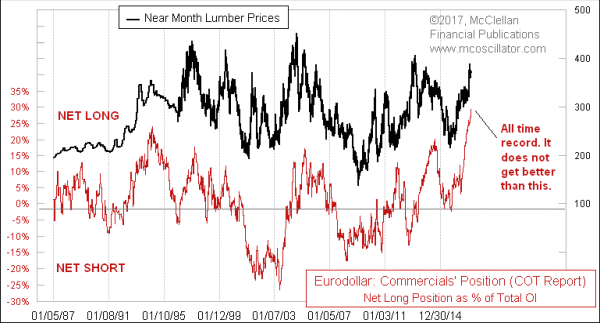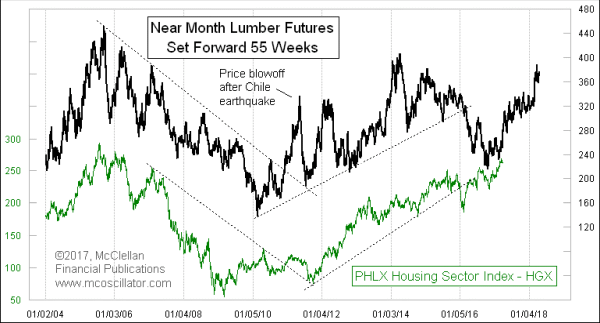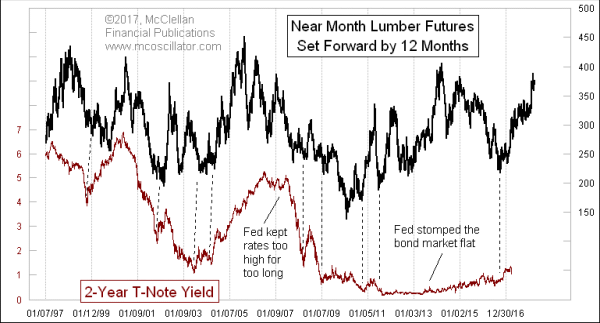 Intermarket relationships are fun. They often reveal surprising relationships, and those relationships are all the more fun when they offer us insights from which we can make money.
Intermarket relationships are fun. They often reveal surprising relationships, and those relationships are all the more fun when they offer us insights from which we can make money.
This week, we look at the important data from the Commitment of Traders (COT) Report, which I have previously shown have importance for the stock market. See this, and this, and also this.
You might wonder, who cares about COT data for eurodollar futures. Well, you would, if you knew the great leading indication it gives for the stock market a year later. But it also has importance in other ways.
This week’s chart shows that the commercial traders’ net position in eurodollar futures is very well correlated to the movements of lumber futures prices. I have previously shown how lumber futures prices give a great leading indication for interest rates, housing starts, and other important economic series.
Lumber prices are unique in that they reflect multiple economic inputs, and so lumber prices sit at the intersection of all of those factors. “Timber” refers to logs that are standing as trees, or freshly cut. To turn “timber” into “lumber”, one must add costs of transportation, electricity (for milling), labor, cost of capital, storage, and shipping once again. So lumber prices reflect more than just the cost of trees, or the demand for 2x4s.
The value of the Commitment of Traders (COT) Report data for eurodollar futures is something I have written about before concerning the stock market. In that usage, the eurodollar COT data give a 1-year leading indication for how the SP500 will move.
But this is the first time I have shown a comparison to lumber prices. This one has the two plots shown on a coincident basis, i.e. no time offset. They show a very close correlation, and the importance of that point is when the eurodollar COT data get to an extreme value, that usually marks a turning point for lumber prices.
That is important right now because we are looking at the largest net long position for the commercials (as a % of total open interest) in the entire 31-year history of the COT Report data. This suggests there is not much further to go for either that data, or for lumber prices. And as a stock market leading indication, it says to be looking for a peak about a year from now, but a really fun bullish time leading up to that peak.
A peak for lumber prices now might not seem that important to most people. Hardly anyone trades lumber futures, and indeed total open interest in lumber futures typically ranges from around 3500 to 6000 contracts. It is a tiny futures market (eMini SP500 futures have around 2.8 million contracts, for comparison).
But lumber prices are terribly important as an economic indicator. They tell us about what interest rates and housing data are going to do over the next year. Here is what I mean:

 So if lumber is indeed topping out now, then we can look for growth in housing to top out about a year from now, and the same for short term interest rates. But we don’t know yet that lumber is topping now, nor that the eurodollar COT indicator is going to turn down now. We just know that both are stretched. So for that forecast of a year from now, we need to watch how both the eurodollar COT data and lumber prices behave over the next few months. That will be a topic we cover and update in our twice monthly McClellan Market Report and our Daily Edition.
So if lumber is indeed topping out now, then we can look for growth in housing to top out about a year from now, and the same for short term interest rates. But we don’t know yet that lumber is topping now, nor that the eurodollar COT indicator is going to turn down now. We just know that both are stretched. So for that forecast of a year from now, we need to watch how both the eurodollar COT data and lumber prices behave over the next few months. That will be a topic we cover and update in our twice monthly McClellan Market Report and our Daily Edition.
Tom McClellan
Editor, The McClellan Market Report
